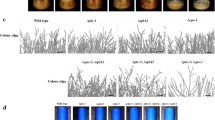Abstract
Tatum's and Beadle's1 investigations on Neurospora inspired me to attempt to induce physiological mutations in Ophiostoma multiannulatum (Hedge, and Davids.) by means of X-ray treatment. Normal strains of this fungus grew optimally on a synthetic medium containing glucose, ammonium tartrate, inorganic salts, aneurin (= vitamin B1) and pyridoxin (= vitamin B6)2. Out of 775 monosporous mycelia which were obtained from X-ray treated ascospores by means of a special procedure3, 12 (that is, 1·6 per cent) differed physiologically. The manner in which they differed is shown in the accompanying table.
Similar content being viewed by others
References
Beadle G. W. and Tatum E. L., Nat. Acad. Sci. Proc., 27, 499 (1941). Tatum E. L. and Beadle G. W., ibid., 28, 234 (1942). (only available in abstracts.)
Fries N., Symb. Bot. Upsal., 7, 2 (1943).
Fries N., Ark. Bot., 32, 4 (1945).
Volkonsky M., C.R. Soc. Biol. Paris, 109, 528 (1932).
Fildes P. and Richardson G. M., Brit. J. Exp. Pathol., 18, 292 (1937).
Author information
Authors and Affiliations
Rights and permissions
About this article
Cite this article
FRIES, N. X-Ray Induced Mutations in the Physiology of Ophiostoma. Nature 155, 757–758 (1945). https://doi.org/10.1038/155757a0
Issue Date:
DOI: https://doi.org/10.1038/155757a0
- Springer Nature Limited
This article is cited by
-
Studies on the black rot of coffee
Proceedings / Indian Academy of Sciences (1954)
-
Mutations Induced in Coprinus fimetarius (L.) by Nitrogen Mustard
Nature (1948)
-
Experiments with Different Methods of Isolating Physiological Mutations of Filamentous Fungi
Nature (1947)





